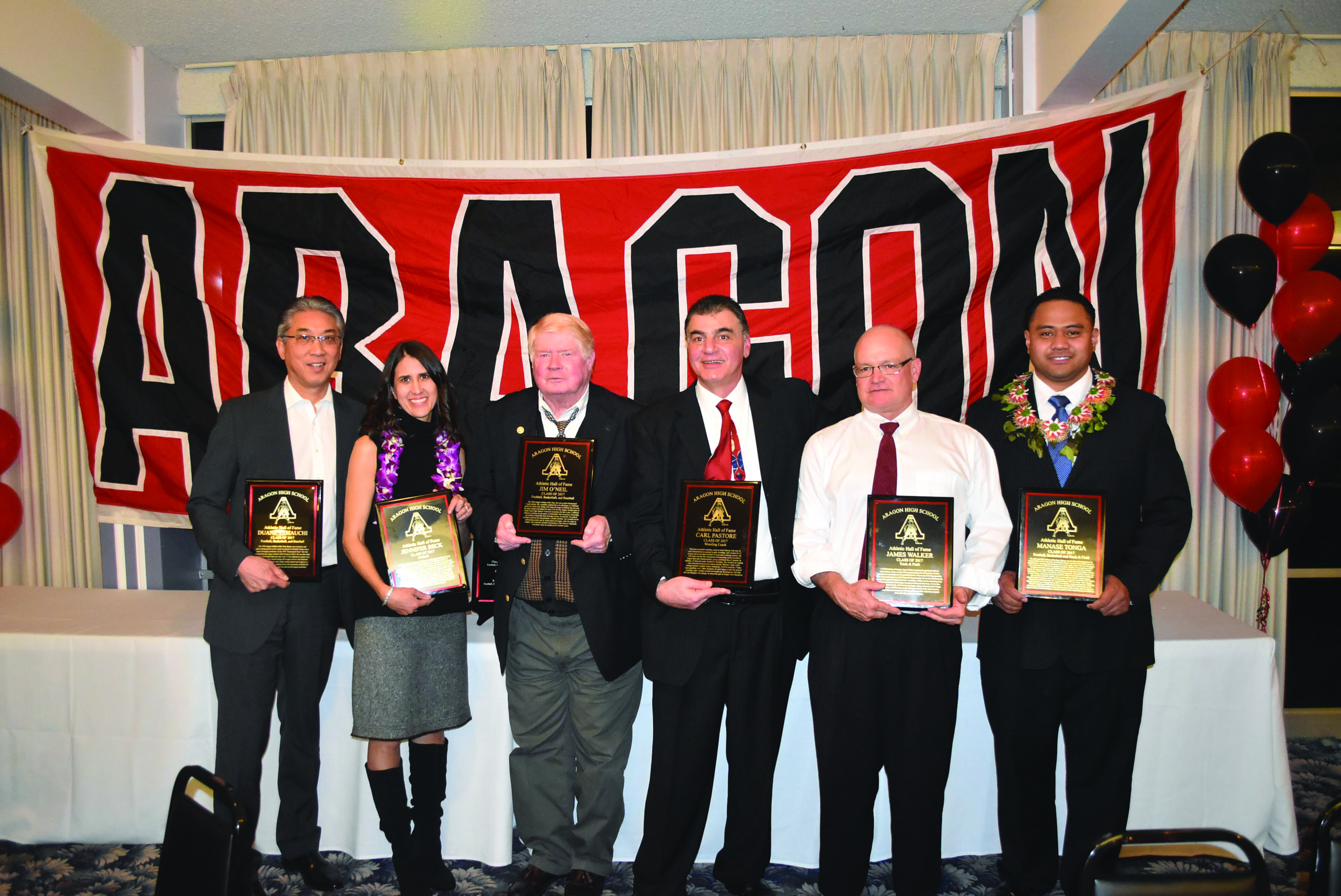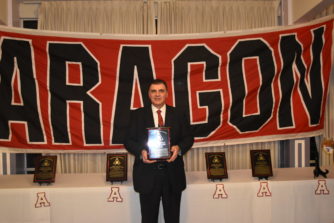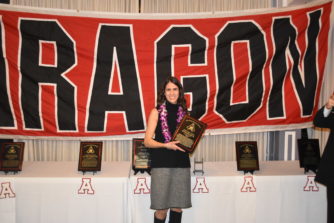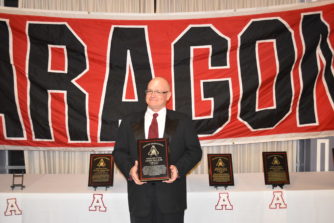
Manase Tonga

The only Don to score a National Football League touchdown, Tonga was the face of Aragon athletics in the early 2000’s. He was the 2001 and 2002 Male Athlete of the Year — a rare feat to be named so twice. The MVP of his Frosh-Soph basketball team, Tonga went on to start for three years at the varsity level. He also was an exceptional track and field athlete, winning the league championships in the long jump, triple jump, high jump and 4 x 100 meter relay. But Tonga’s most dominant sport was football, where he scored 50 touchdowns throughout his career in the red and black, and had his No. 5 jersey retired.
Despite his ultimate success on the football field, Tonga nearly called it quits after his first year: “After my freshman season of playing football — my first year ever of playing football — I sucked. I was literally on the verge of saying, ‘You know what, I’m just gonna stick to basketball,’” he explains. “And for some odd reason, Coach Sell came to me, he approached me, and asked me if I wanted to move up to varsity … He saw something in me that I didn’t, and I think that was a turning point. And from there, the rest is history.
Tonga quickly developed a close relationship with football coach and athletic director Steve Sell, who told the crowd at the ceremony that it is difficult for him to talk about Tonga dry-eyed. However, one event in particular stands out to Sell: “When [Tonga] was probably a junior … I started bringing my young son to practice on Saturdays. And we’re in the office, we’re watching film, I turn around, and my son’s gone … I scramble out of the room, and I walk out, and there’s [Tonga] holding my son. And it was like it was typical.”
Tonga went on to have one of the most successful athletic careers in Aragon history. He played four seasons on the Brigham Young University football team, where he scored 24 touchdowns, before being signed by the NFL’s Oakland Raiders, who released him in 2012.
Carl Pastore

Many Aragon students recognize the friendly smile of special education teacher Carl Pastore, but few know the legacy he has left in the high school wrestling community.
Pastore headed Aragon’s wrestling team for 19 years, and had 15 non-losing seasons — 12 of which were consecutive. He coached 12 CCS medalists and one state champion, and at a time in which it was common for wrestling programs to have a varsity team, a junior varsity team, and a developmental team, Pastore’s wrestling dynasty was so dominant that he fielded two varsity teams and one JV team.
However, Pastore will be remembered most for spearheading a movement to include girls in high school wrestling. “I solved discrimination with girls in wrestling,” he says. “One way to stop it was to get involved into the politics. So I became the league [representative], and I sat on the CCS Wrestling Committee … Now there was no true power there, but I had a voice. And it was kind of loud. And the first thing that we did was add the word ‘girls’ to the PAL Wrestling Bylaws.”
Pastore’s innovations quickly increased Aragon’s success in the sport. “Aragon’s only state champion was a girl,” he explains. “We sent eight girls to the NorCals, and eight girls came back with medals. Pretty impressive.”
The former coach developed a winning strategy that revolved around exposing his wrestlers to what Pastore refers to as “the top level,” which included professional football players, professional boxers, and Olympic head coaches.
“When you take [the wrestlers] to the best … then those skills are passed down from one generation to the next generation and it’s all about technique,” he explains.
Pastore’s work has been recognized throughout the country as well. In 2002, the Teacher Education Weekly published an article about the best girls wrestling program in the country, and as Pastore says, “They found it at 900 Alameda de las Pulgas in San Mateo.”
Jennifer Beck

“Unlike in baseball, in softball, the same pitcher can pitch every game … So if you have a softball program, if you have a dominant pitcher, you are almost guaranteed to be good, and at least more dominant and at least competitive for as long as you have that pitcher. And for three years, Aragon had that pitcher,” Sell says of 1987 graduate Jennifer Beck.
Between her sophomore and senior years, Beck dominated the Peninsula Athletic League. She was named to the All-League, All-County, and All-Peninsula teams all three years, and in her senior year, was named PAL Pitcher of the Year. But perhaps most notably, she owned the pitching mound for the league-champion 1986 softball team, which was inducted into the Aragon Athletic Hall of Fame in 2014.
“There were 12 of us on the [1986] team. We were good friends. There was a lot of good [defensive] and offensive players that made my job as a pitcher easy. We went, I think, it was 32-0 that year,” she explains.
A catalyst of that team’s chemistry came from the most unlikely of sources: eucalyptus trees. During Beck’s years, the foul lines were backed by massive eucalyptus trees, but each day, the trees shedded hundreds of caps onto the field, which could easily become a safety hazard if a player were to trip on them. And with a 12-person roster for an 11-position sport, the team had no room for injury.
“When our team took the field for practice, the first five minutes were spent not stretching or warming up, not discussing the practice plan or jogging, but instead, we spent the first five minutes of every practice, without fail, gathering eucalyptus caps,” she recalls. “We didn’t want any sprained ankles, so that’s how we always started our practice. Our team did this together, and I remember it fondly … Our team laughed and complained about it, but it was always done together, as a team, and we bonded over it.”
After completing her four years at Aragon, Beck joined the the Bay Area’s Jane Eymer Fast Pitch Softball League, and was named the Most Valuable Pitcher.
James Walker

From the second James Walker stepped foot on the Aragon campus in 1975, he was the fastest Don.
“When I began my track and field experience as a freshman, I entered, and I was the fastest one in the school. and it was a little nerve wracking,” he explains. “There were some guys who really didn’t like me,” says Walker. “They had been wanting to be the fastest guy, but I, a freshman, came up and was the fastest.”
Walker had a strong start to his track campaign at Aragon, but it all came to a screeching halt during his junior year. His grades were so poor that he was ineligible to compete in school sports.
But during the summer of 11th grade, Walker had a life-changing conversation with his coach, Bill Daskarolis: “I was down in the locker room for some reason, and there’s [my] coach — just him and I — and he comes over and says hello and asks how I’m doing. And then, he just rips into me and criticizes me left and right. Not only was I hurting myself,” he says, “but I was hurting the team, and I’d really let him down.”
But Daskarolis’ harsh lecture was just what Walker needed. During his senior year, he returned to the team, but became a hurdler. “I picked up the hurdles because we had a couple other sprinters who were a little slower who could still win if I wasn’t there,” he says. “We had no hurdler my senior year and so I thought, well I’ll pick up that because nobody else can hurdle … I wanted to do it for the team.”
That year, Walker became one of the most dominant high school athletes on the Peninsula. He took home the Central Coast Section championship in the 330-yard low hurdles, finishing with a time of 37.85 seconds, while winning second place in the 110-yard high hurdles and running on the league champion 4×100 yard relay team. At one point, he held eight school records.
And he accomplished this all while making the Honor Roll.
After Aragon, Walker went to the College of San Mateo, setting school records in the 100m and 200m sprints. He then attended UCLA and competed in the 100m, 200m, and 4x100m relays.




Well done Zack. Great to share accomplishments of past Dons. Many have gone before and many yet to come to the HOF! Keep up your good work on Aragon sports.
Coach Hunt
XC and Distance in Track